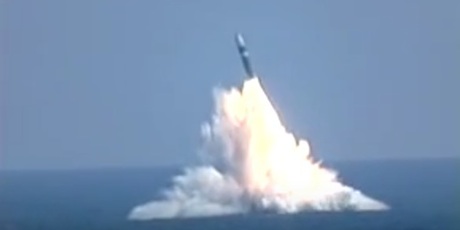By Richard Sisk
The doctrine of nuclear deterrence that leaves open the possibility of launching a “first strike” before an enemy attacks will remain the basis of U.S. policy even as new generations of nuclear weapons are introduced, Defense Secretary Ashton Carter said Tuesday.
“That’s our doctrine now, and we don’t have any intention of changing that doctrine,” Carter told airmen in a question-and-answer session at Kirtland Air Force Base in New Mexico.
Carter was responding to a question about nations such as Russia and North Korea “brandishing” their nuclear arsenals to bully and intimidate and whether the U.S. would follow suit.
“It’s not the American approach to brandish, not the American approach to intimidate,” Carter said. “For as long as I can remember,” U.S. leaders “have always conducted themselves with tremendous respect for the awesome destructive power of these weapons.”
However, Carter suggested that the deterrence doctrine might have to be “adjusted” in the future to adapt to new threats. “We can’t just do things the old way,” he said. “We have to look at those whom we’re deterring and adjust what we’re doing to take that into account.”
The U.S. must “be aware that others are thinking differently about nuclear weapons,” Carter said, and “we’re going to have to adapt our approach to deterrence accordingly.” He did not give details on how the U.S. might adapt.
Since the dawn of the nuclear era, the basis of U.S. deterrent doctrine has been that any enemy “first strike” would be met by an overwhelming response. But no U.S. president has ruled out the possibility of launching a nuclear attack first before an enemy strikes.
In response to reports that President Obama has been considering ruling out a “first strike” by executive order, 30 U.S. senators last week sent Obama a letter urging him to retain the “first strike” option.
The first strike policy figured in the debate Monday night between Republican presidential candidate Donald Trump and Democratic candidate Hillary Clinton.
At first, Trump appeared to argue for scrapping the nuclear weapons stockpiles. “I would like everybody to end it, just get rid of it,” he said, and “I would certainly not do first strike.”
Then Trump seemed to reverse course: “At the same time, we have to be prepared. I can’t take anything off the table.”
Clinton attacked Trump’s previous comments suggesting the U.S. may benefit from such allies as Japan, South Korea and Saudi Arabia developing nuclear weapons. “His cavalier attitude about nuclear weapons is so deeply troubling,” she said.
Kirtland was the second stop on Carter’s week-long trip to press for modernization of the nation’s nuclear triad and also renew the U.S. commitment to the rebalance of U.S. forces to the Pacific region.
On Monday, Carter was at Minot Air Force Base in South Dakota, home to the 5th Bomb Wing and 91st Missile Wing, where he said DoD was seeking $108 billion over the next five years to begin the process of upgrading the nation’s nuclear triad of Intercontinental Ballistic Missiles, ballistic submarines and strategic bombers.
“I think we are now committed to make up for some time when we were not investing enough,” Carter said at Kirtland, home of the 377th Air Base Wing and the 498th Nuclear Systems Wing, as well as the Air Force Materiel Command’s Nuclear Weapons Center (NWC). The NWC has responsibility for the acquisition and modernization of nuclear programs for the departments of Defense and Energy.
On Wednesday, Carter will tour the Sandia and Los Alamos National Laboratories in New Mexico, and on Thursday he was scheduled to be aboard the aircraft carrier Vinson in San Diego harbor for a speech on the growing U.S. priorities in the Pacific. Carter will then travel to Honolulu for meetings with Asian defense ministers.
The Congressional Budget Office has projected spending for modernization of the nation’s nuclear arsenal through 2024 at about $348 billion. In its report, the CBO said:
** “The current strategic nuclear forces — consisting of submarines that launch ballistic missiles (SSBNs), land-based intercontinental ballistic missiles (ICBMs), long-range bombers, and the nuclear weapons they carry — are reaching the end of their service lifetimes.”
** “Over the next two decades, the Congress will need to make decisions about the extent to which essentially all of the U.S. nuclear delivery systems and weapons will be modernized or replaced with new systems.”











